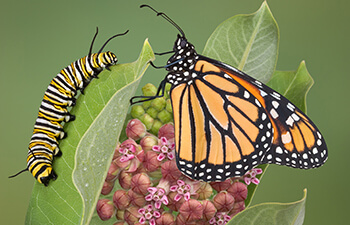

Manage Insects Naturally
Keep your plants healthy from the beginning. Healthy plants are more able to resist and recover from insect damage. Start by examining your soil, sun and environmental conditions to help you select plants that will thrive in your native conditions. Build healthy soil with compost and proper mulching techniques. Before amending with fertilizer, consider getting a soil test done. Transplant into the soil in fall or spring when rainwater will help your plants become established. Employ smart watering techniques, watering deeply but infrequently. Again, be sure to place plants in the part of your yard that matches their soil and sun needs. It’s OK to replace problem plants. (They make great compost!)
Attract beneficial insects to control problem insects by planting flowers that provide nectar, pollen and shelter. Trees and flowering plants can also provide food and shelter to insect-eating birds.
Get help with identification in our Beneficial Insects document so you don't kill a helper.
Use non-chemical least-hazardous methods. Use water spray to knock down aphids. Try traps for wasps, moths and whiteflies. Cover apples with heavy duty nylons or baggies when they are the size of a quarter to deter apple maggot and codling moth.
Use pesticides only as a last resort. Pesticides pose varying risks to people, pets and beneficial insects. Keep using non-toxic methods and over time you can reduce pest numbers and the damage they cause.
If you choose to use pesticides, pick a safer product using Grow Smart, Grow Safe product tables.
